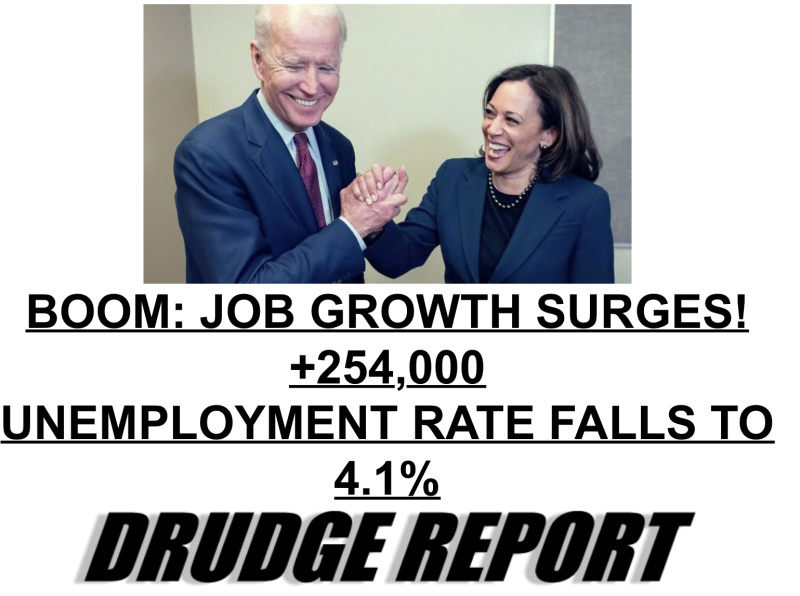
Posted on 10/04/2024 8:58:02 AM PDT by thegagline

These numbers may be revised in a downward manner next month...
Unexpectedly, of course.
Team Trump said majority of jobs went to illegals:
https://townhall.com/tipsheet/katiepavlich/2024/10/04/team-trump-notes-a-key-fact-about-the-latest-job-numbers-n2645737
Lies, damned lies, and statistics.
To be amended, probably after the election.
#41 I was listening to a former radio host filling in for a show at KFI 640 in Los Angeles on Friday and he said he was reading the Drudge Report....
That is like having a AOL account and you are using dialup.
I was shocked anyone was as they are now owned by a couple who works at google which means Google. The host is a liberal who likes to reference little known things in order to sound smart. Plus the things are decades old like some baseball reference and he still talks smack about Reagan. He has RDS.
Here is a post about the fake job numbers showing the revised numbers.
Showing almost all are revised to a negative number from Jan 2023 to July 2024.
https://x.com/someBKLYNguy/status/1842186488064487935
Greg Price @greg_price11
Here’s everything you need to know about the so-called great jobs report:
https://x.com/greg_price11/status/1842212408330178955
Over the last year, employment for native born American workers fell by 825K
For foreign born workers, it increased by 1.2M.
More lies from Harris-Biden Reich. I write Harris-Biden, because everyone knows Biden is too cognitively impaired to be doing anything.
Copium and Hopium is visible throughout this string. This is a strong report, unfortunately.
here is a report from FT Advisors. I personally know Brian Wesbury the economist who is the author of the report. He is a conservative economist
here is his analysis. Make of it what you will
First Trust
Data Watch
Nonfarm Payrolls Increased 254,000 in September
Brian S. Wesbury, Chief Economist
Robert Stein, Deputy Chief Economist
Date: 10/4/2024
Nonfarm payrolls increased 254,000 in September, easily beating the consensus expected 150,000. Payroll gains for July and August were revised up by a total of 72,000, bringing the net gain, including revisions, to 326,000.
Private sector payrolls rose 223,000 in September and were revised up by 21,000 in prior months. The largest increases in September were in restaurants & bars (+78,000), health care & social assistance (+72,000), and construction (+25,000). Government rose 31,000 while manufacturing declined 7,000.
The unemployment rate ticked down to 4.1% in September from 4.2% in August.
Implications: The labor market was strong in September, but not quite as strong as the headlines suggest. First the evidence of strength. Nonfarm payrolls rose 254,000 for the month, easily beating consensus expectations and higher than every forecast on Bloomberg. Payroll growth in prior months was revised up, as well. Meanwhile, civilian employment, an alternative measure of jobs that includes small-business start-ups increased 430,000. As a result of the job growth, the unemployment rate ticked down to 4.1% in September, the lowest level since June.
We like to follow payrolls excluding three sectors: government, education & health services, and leisure & hospitality, all of which are heavily influenced by government spending and regulation (that includes COVID lockdowns and reopenings for leisure & hospitality).
This “core” measure of jobs increased a respectable 64,000 for the month, beating the 47,000 average per month in the past year. In addition to the job growth, wage growth was strong, as well, with average hourly earnings up 0.4% in September and up 4.0% from a year ago, which is outstripping inflation.
So what’s not to like? First, in spite of all the job growth the total number of hours worked in the private sector slipped 0.1% in September. How can that be? Because the average workweek ticked down to 34.2 hours versus 34.3 in August.
In other words, in the aggregate, there was less work to go around in September so the net hiring resulted in each worker working less.
The second negative sign was that those without jobs are taking longer to find jobs; the median duration of unemployment rose to 9.9 weeks in September, the longest since early 2022.
What does the report mean for the Federal Reserve? That Chairman Powell’s recent hint that rate cuts will be slower than the kick-off 50 basis point cut in September should be taken seriously.
A rate cut the day after the election still looks likely, but it’s much more likely to be a quarter percentage point, not a half.
Why cut at all? Because monetary policy has been tight enough to bring inflation down much closer to the Fed’s target of 2.0% and it takes time for shifts in monetary policy to affect the economy.
Some will see today’s report as a reason to completely ignore recession risk, but, given the lags in policy, there is downside risk in the year ahead.
Public schools. Tax.✖️ Tax✖️ Tax. ✖️
Disclaimer: Opinions posted on Free Republic are those of the individual posters and do not necessarily represent the opinion of Free Republic or its management. All materials posted herein are protected by copyright law and the exemption for fair use of copyrighted works.